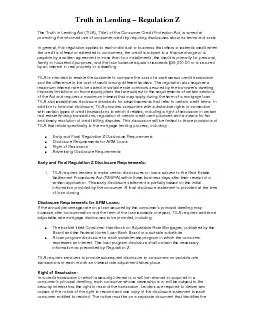

The Truth in Lending Act TILA Title I of the Consumer Credit Protection Act is aimed at promoting the informed use of consumer credit by requiring disclosures about its terms and costs In general ID: 828058
Download Pdf The PPT/PDF document "Truth in Lending – Regulation Z" is the property of its rightful owner. Permission is granted to download and print the materials on this web site for personal, non-commercial use only, and to display it on your personal computer provided you do not modify the materials and that you retain all copyright notices contained in the materials. By downloading content from our website, you accept the terms of this agreement.
Truth in Lending – Regulation Z Th
Truth in Lending – Regulation Z The Truth in Lending Act (TILA), Title I of the Consumer Credit Protection Act, is aimed at promoting the informed use of consumer credit by requiring disclosures about its terms and costs. In general, this regulation applies to each individual or business that offers or extends credit when the credit is offered or extended to consumers; the credit is subject to a finance charge or is Truth in Lending – Regulation Z rescission period on the transaction and must clearly and conspicuously disclose the retention or interest in the consumer's principal dwelling; the consumer's right to rescind the transaction; and how the consumer may exercise the right to rescind with a form for that purpose, designating the address of the lender's place of business. In order to exercise the right to rescind, the consumer must notify the creditor of the rescission by mail, telegram or other means of communication. Notice is considered given when mailed, filed for telegraphic transmission or sent by other means, when delivered to the lender's designated place of business. The consumer may exercise the right to rescind until midnight of the third business day following consummation of the transaction; delivery of the notice of right to rescind; or delivery of all material disclosures, whichever occurs last. When more than one consumer in a transaction has the right to rescind, the exercise of the right by one consumer shall be effective for all consumers. When a consumer rescinds a transaction, the security interest giving rise to the right of rescission becomes void and the consumer will no longer be liable for
any amount, including any finance charge
any amount, including any finance charge. Within 20 calendar days after receipt of a notice of rescission, the lender is required to return any money or property that was given to anyone in connection with the transaction and must take any action necessary to reflect the termination of the security interest. If the lender has delivered any money or property, the consumer may retain possession until the lender has complied with the above. The consumer may waive the right to rescind if the consumer determines that the extension of credit is needed to meet a bona fide personal emergency. To waive the right, the consumer must give the lender a dated written statement that describes the emergency, specifically modifies or waives the right to rescind and bears the signature of all of the consumers entitled to rescind. Printed forms for this purpose are prohibited. Advertising Disclosure Requirements:If a lender advertises directly to a consumer, TILA requires the advertisement to disclose the credit terms and rate in a certain manner. If an advertisement for credit states specific credit terms, it may state only those terms that actually are or will be arranged or offered by the lender. If an advertisement states a rate of finance charge, it may state the rate as an "annual percentage rate" (APR) using that term. If the annual percentage rate may be increased after consummation the advertisement must state that fact. The advertisement may not state any other rate, except that a simple annual rate or periodic rate that is applied to an unpaid balance may be stated in conjunction with, but not more conspicuously than, the annual percentage rate